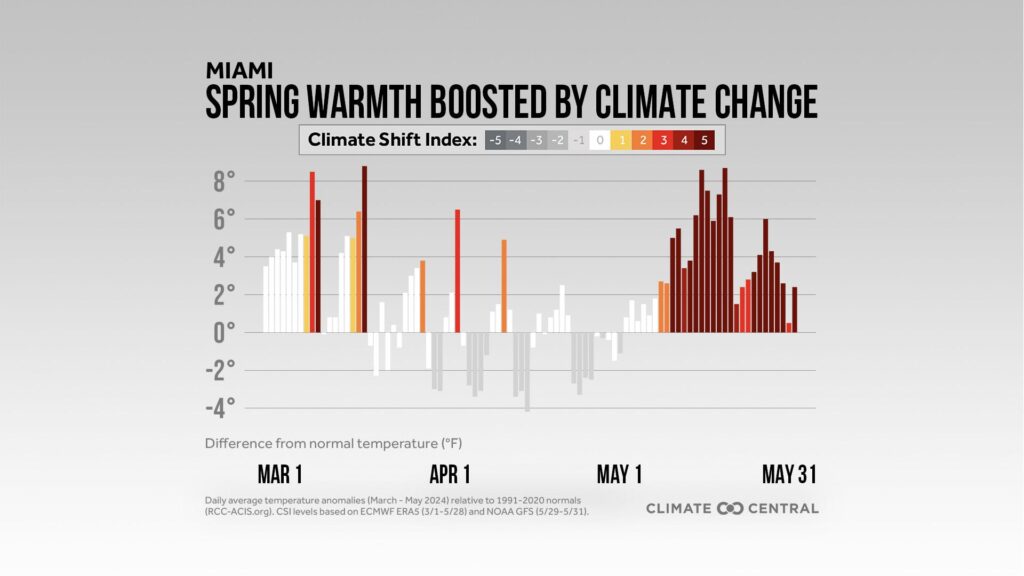By Kristan Reynolds, The Invading Sea
Billions of people, including Floridians, experienced record-breaking heat worldwide from March to May that was made more likely by climate change, according to a new report by Climate Central.
In Florida alone, several cities experienced their hottest May on record, which was made more likely by climate change, according to the report. May 2024 will also likely set the record for the highest statewide average temperature for the month, according to David Zierden, Florida’s state climatologist.
Higher-than-average global temperatures are expected to continue into the summer and can cause serious health risks such as heat-related illnesses, Zierden said.
“Miami International Airport reached a heat index of 112°F on May 18th, and that was an all-time record for the month of May, and also on May 15th, Key West recorded a heat index of 114°F, which, again, was an all-time May record,” Zierden said. “This is very early in the season to really be seeing these kinds of high heat index values.”

Climate Central’s report highlights that 17 cities in the United States, which are mainly located in Texas and Florida, experienced 10 days of temperatures that were made at least three times more likely by climate change.
“Certainly we can’t ignore the underlying trend of the last few decades and the general warming trend that is attributable to anthropogenic (human-caused) greenhouse gasses — we are seeing the climate change signal,” Zierden said. “The oceans surrounding Florida — the North Atlantic, the Caribbean, the Gulf of Mexico — are all running at basically record-hot levels right now for the month of May. With these much warmer than normal, or even record-setting ocean temperatures, that’ll keep the overnight cooling down, humidity values higher and just generally support this continued increased heat in the state of Florida.”
Central Florida was one of the Florida regions that experienced record-breaking temperatures during May. Some Central Florida first responders are preparing for a hot summer following the repetitive high temperatures recorded throughout the spring.
“We now have not one, but two rehab trucks available for large-scale or long-term incidents for our first responders to be able to do,” said Aaron Imeson, who is battalion chief of the Seminole County Fire Department and currently oversees the Emergency Medical Services division. “We work very well and closely with emergency management and providing water and ice and shaded areas for those that are in need, so here in Seminole County, we are prepared as you could possibly get for the weather conditions we have all year round.”
Although high temperatures pose health risks for everyone, Zierden said that vulnerable populations, such as outdoor workers and those without air conditioning, are at the highest risk. Heat protection is a “priority for all of our workers, especially new workers, who are not used to working out in the heat,” said Liett Lipker, executive director of Power Washers of North America, a nonprofit organization that provides worker safety education.
“As far as being hydrated, and having the proper clothing on and knowing when to take breaks, a newer employee may think they’re fine, and not being used to being outside could affect them quicker,” Lipker said.
In order to prevent heat-related illnesses, Lipker, a Florida resident, advises outdoor workers to hydrate prior to working, find shade whenever possible and take frequent breaks to rehydrate and rest. She also said that employers should provide personal protective equipment such as wide-brim hats, UV eyewear, sunscreen and lightweight UV clothing.
“This is what we teach in our courses, is be ready for those emergencies and have a course of action just in case,” Lipker said. “If you have an employee that is showing signs of (heat illness), make sure they get rest, make sure they are hydrated and seeking medical attention if necessary. Employers are encouraged to protect their employees from the onset.”

According to Zierden, temperatures for May 2024 ran four to six degrees Fahrenheit higher than past averages for May. Zierden says that temperatures are likely to remain above average into the summer season, especially with the warm sea surface temperatures recorded in the Atlantic, Gulf of Mexico and the Caribbean.
“Just because May is close to setting a record for the warmest May yet, that does not necessarily mean that the rest of the summer will also set records, but it does mean that there’s a very good chance that they’ll be much warmer than normal,” Zierden said. “We can anticipate increased heat regardless of whether we set records the remainder of the summer.”
In order to avoid heat illness this summer, Imeson recommends to wear protective clothing, hydrate and minimize time spent in the sun during peak heat.
“Between 1 and 4 p.m. is really our hottest time of the day here in Florida. Try to plan your activities accordingly around that, so you’re not out in the middle of the heat of the day,” Imeson said.
Imeson notes that infants and the elderly are especially at risk for heat-related illnesses due to weaker regulation of body temperatures. Preexisting medical conditions, such as diabetes, and certain medications can also make people more susceptible to heat illness, Imeson said.
Zierden says that if the concentrations of greenhouse gasses continue to increase every year, “We will continue to see this overall warming trend in our planet’s climate.”
Kristan Reynolds is a Florida Atlantic University senior majoring in multimedia journalism and minoring in communication studies who is reporting for The Invading Sea during the summer 2024 semester.
Sign up for The Invading Sea newsletter by visiting here. If you are interested in submitting an opinion piece to The Invading Sea, email Editor Nathan Crabbe at ncrabbe@fau.edu. To learn more about the heat index, watch the video below.



